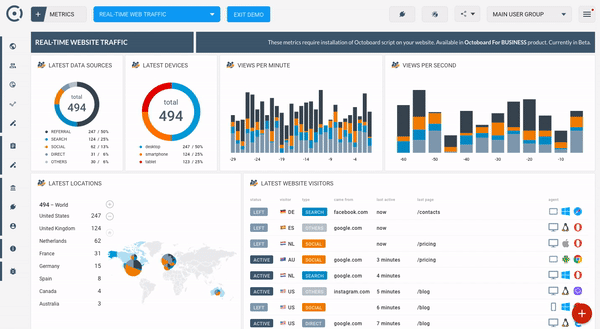Web Analytics Overview: Revolutionizing Marketing Performance with Octoboard's Real-Time Dashboards and Google Analytics Metrics
Learn about the importance of web analytics and how it can revolutionize marketing strategies.
WEB ANALYTICS OVERVIEW
Key web analytics metrics in a live dashboard

In today's digital age, marketing teams are inundated with data from various channels, making it challenging to track and analyze performance efficiently. The advent of Marketing Analytics dashboards, particularly those leveraging Google Analytics data, has revolutionized how teams monitor, analyze, and act on this data. This blog post delves into the creation of real-time Marketing Analytics dashboards, focusing on a Web Analytics overview using the Octoboard analytics platform.

Importance of Google Analytics Metrics for Marketing Teams
Google Analytics offers a treasure trove of data that can help marketing teams understand their website's performance. By analyzing metrics such as Countries by Sessions, Metrics by Countries, Sessions by Days, Users by Days, Pageviews by Days, Metrics by Traffic Types, Metrics by Mediums, and Metrics by Devices, teams can gain insights into who their audience is, how they interact with the website, and which channels drive the most value.
For instance, understanding the "Countries by Sessions" metric can help businesses tailor their content and marketing strategies to specific geographical locations. Similarly, "Metrics by Traffic Types" and "Metrics by Devices" provide invaluable insights into how users access the website, enabling optimizations for better user experiences across different devices and traffic sources.

Automating Marketing Analytics Dashboards with Octoboard
Using platforms like Octoboard to automate the creation of Marketing Analytics dashboards can save marketing teams hundreds of hours. These dashboards not only automate data collection and analysis but also enable real-time monitoring of marketing performance. Displaying a comprehensive Google Analytics dashboard in an office provides visibility into Marketing Analytics efforts, fostering a data-driven culture within the organization.
Octoboard's integration with Google Analytics through cloud data APIs enables it to fetch real-time data, ensuring that marketing teams are always up-to-date with their progress. This level of automation and integration simplifies the complex process of data analysis, allowing teams to focus on strategic decisions rather than data collection and manual analysis.
Consolidating PPC Reporting
In addition to web analytics, Octoboard offers a solution for consolidating PPC (Pay-Per-Click) reporting across multiple channels. This is crucial as it allows marketing teams to track advertising metrics such as impressions, user engagement, locations, and devices in one unified platform. By bringing all PPC reporting to one place, teams can compare performance across channels, optimize campaigns more effectively, and ensure the best possible ROI on advertising spend.
Octoboard's advanced PPC Analytics module further enhances this capability by allowing marketing teams to build new metrics, dimensions, and use advanced formulas. This feature is particularly valuable for marketing agencies that manage campaigns across different locations and currencies, enabling them to tailor reports to the specific needs of their clients.

Automating Data Detection of Trends
One of the standout features of Octoboard is its ability to monitor data trends and generate insights using Google Analytics data. This automated data detection capability ensures that marketing teams are always aware of significant changes or trends in their data, enabling them to act swiftly on these insights.
Octoboard's integration with ChatGPT/OpenAI for generating data insights represents a leap forward in data analytics. By leveraging AI to analyze trends and anomalies, marketing teams can gain a deeper understanding of their performance, identify opportunities for optimization, and stay ahead of the competition.

Google Sheets Data Export Feature
Another useful feature of Octoboard is its Google Sheets data export capability. This feature allows marketing teams to send cloud data directly to Google Sheets, facilitating further analysis, sharing, and collaboration. The ability to export data to Google Sheets is especially beneficial for teams that prefer to manipulate or visualize their data in custom ways or need to share insights with stakeholders who may not have access to the Octoboard platform.
The Octoboard Google Sheets add-on simplifies the process of data transfer, ensuring that teams have the flexibility to use their data as needed, without being confined to a single platform or format.
Conclusion
In conclusion, the integration of Google Analytics data into real-time Marketing Analytics dashboards, facilitated by platforms like Octoboard, represents a significant advancement for marketing teams. By automating the creation and analysis of dashboards, teams can save time, gain real-time insights, and make data-driven decisions more effectively. The consolidation of PPC reporting, advanced analytics capabilities, and the automation of data trend detection are just a few examples of how Octoboard transforms marketing analytics. These features, combined with the ability to export data to Google Sheets, provide marketing teams with the tools they need to monitor their performance, optimize their strategies, and achieve their marketing objectives more efficiently.
Octoboard customers who created this report also used the following data templates:

Google Analytics - Overview

Campaigns and Events

Web Analytics overview

Google Analytics SEO template - Audience (Report)

Google Analytics - Audience

Google Analytics All Metrics

Real-Time Traffic, Email, Payments

Google Analytics SEO dashboard - All Traffic

Real-Time website traffic

Google Analytics Landing Pages (report)

Google Analytics Location details
